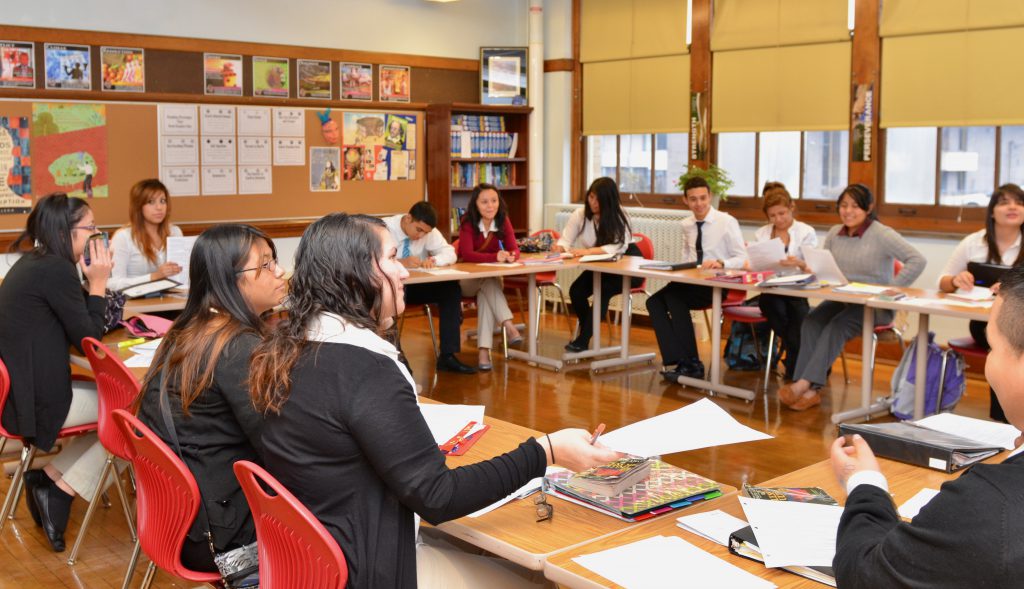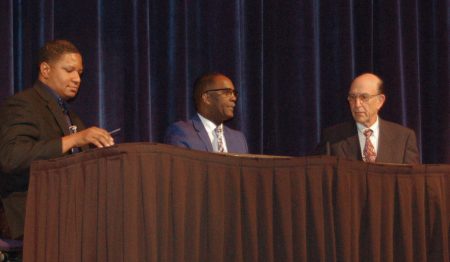Schools to Address Urban Segregation?
'The Color of Law' event triggers local efforts to create history courses on how government segregated cities.

The curriculum on the government’s role in segregation will be designed for middle and high schools students such as these at Carmen High School of Science and Technology South Campus. Photo by Sue Vliet/NNS.
When organizers invited author Richard Rothstein to Milwaukee to speak about his book, “The Color of Law: A Forgotten History of How Our Government Segregated America,” they hoped that the presentation would lead to action. At the conclusion of the October event, they asked attendees to vote on which of 13 proposals they would like to see implemented.
The 183 attendees who responded voted overwhelmingly for creating a curriculum to teach middle and high school-age children the history that Rothstein laid out, said Kori Schneider-Peragine of the Metropolitan Milwaukee Fair Housing Council, which sponsored Rothstein’s appearance along with LISC Milwaukee, AFT Local 212 and MATC.
Some other potential actions listed on the ballot (in order of votes received) included: an exclusionary zoning ban; inclusionary zoning; and creating affordable housing units with the development of market–rate units.

(From left) Jarrett English, a community organizer, and Reggie Jackson, head griot at America’s Black Holocaust Museum, lead a panel discussion with author Richard Rothstein following his presentation on Oct. 16. Photo by Allison Dikanovic/NNS.
Schneider-Peragine noted that almost everyone who voted said they were willing to work on some of these initiatives.
Three people, all of whom are white, contacted Schneider-Peragine to volunteer to lead the effort to create a school curriculum that teaches the history of deliberate segregation.
Glendale resident Heidi Erstad said she has worked in education for more than 30 years as a teacher, curriculum director and consultant.
Erstad, together with volunteers Steve Miner, assessment commissioner of the City of Milwaukee, and Steve Schaffer, an archivist at the Milwaukee County Historical Society, are still in the early stages of the project, Erstad said.
They have just begun to define “the scope and shape of (the curriculum) so that we can more clearly describe it” when others who signed up to work on this initiative join in, Erstad said. They are investigating what materials are available to help them localize ‘The Color of Law” in an engaging way for middle and high school students, she said.
Among their early efforts are preliminary discussions with people who have primary resources or deep knowledge of the history of segregated housing in Milwaukee, according to Erstad. Those include Reggie Jackson, head griot at America’s Black Holocaust Museum and librarians from Milwaukee Public Library.
Erstad, Miner and Schaffer are also investigating instructional frameworks, such as Teaching Tolerance’s “Teaching Hard History: American Slavery,” that might be useful in designing teaching materials. Teaching Tolerance is a project of the Southern Poverty Law Center whose mission is to prevent the growth of hate. It develops materials for educators and offers educator grants.
Erstad said she volunteered to work on the project because she feels she needs to help make amends for hypocrisy and omissions in the way the country’s racialized history is taught. “I’m … disturbed by my own complicity in furthering half-truths and mistruths as an educator and throughout the majority of my adulthood,” Erstad said.
Schaffer said he has always been interested in race in the U.S. but, like many Northerners, he thought racial segregation was only practiced in the South. After forming a group of archivists to participate in the “community-wide book read” of “The Color of Law,” he realized his mistake.
“Rothstein’s book is a real slap in the face for people like me,” who believed Milwaukee was different, Schaffer said.
He plans to research pertinent documents and other resources at the Historical Society and, with Erstad and Miner, figure out how to incorporate them in school curricula.
Schaffer also said he is particularly interested in making the Historical Society more relevant to all Milwaukeeans. Rather than engaging only those who want to look back on the city’s history nostalgically, he hopes to show “some of the hard history” and engage minority residents who also have a history in Milwaukee.
Rothstein has continued to be involved in the response to his book and his presentation in Milwaukee, checking in and connecting volunteers to people working on related initiatives in other cities, Schneider-Peragine added.
The Milwaukee Metropolitan Fair Housing Council has no staff or funding to pursue follow-up initiatives to “The Color of Law” event, according to Schneider-Peragine. However, she said the staff decided that “when you have people motivated and ready to be engaged … it’s a really beautiful thing” and they want to cultivate that to the extent that they can.
This story was originally published by Milwaukee Neighborhood News Service, where you can find other stories reporting on eighteen city neighborhoods in Milwaukee.





















Understanding history and dealing with the past are critical to moving forward. But they are never enough, and, especially in segregated places like Milwaukee, they can also be a trap. A trap that in the end reinforces existing mistrust and pessimism about the possibilities for real change. Studying this history can’t be about making white people feel better about themselves because they now understand what happened, or reinforcing black people’s body of evidence on white racism. For something good to come of it, it has to lead to action, and those actions, given the reality “on the ground” have to go well beyond school curricula, changes in zoning, building some affordable housing and other green shoots.
Here are some assumptions to be considered and challenged if they are found to be wrong:
(1) Milwaukee’s pattern of segregation has produced results that are similar to those anywhere where walls are built between people. That result is that, absent much contact, each group’s image of the other becomes progressively more negative, each sees themselves as victims, and each is judged by the other for the worst things they do. The clearest daily example of this is the JS Online comments guys who clearly consider the Hebrew Israelites and the perceived victimization of the MAGA hat white kids as a bigger story than the nation’s history of legal racism.
(2) Given racial attitudes, the scale of inequality and the area’s political dynamics, the likelihood of significant desegregation in the next two decades would appear to be slim. In that time, a first grader in 2019 will have grown into a mid-20s man or woman. What will their life until then have been like? What can be done now to improve those life chances?
(3) Given these realities, a -if not the – major priority of local government (City and County), the business sector, the educational community, and philanthropy should be to collectively find and achieve the outer edges of large scale positive change in these communities.
(4) “Can’t we all just get along” won’t work. Nor will “we can do it with existing resources.” There needs to be a major commitment across sectors to rebuild these communities, and to find and employ every available source of talent, of all colors and groups. Neither “the experts are here to solve your problems,” nor “Don’t lecture us, just give us the money” will work.
In the age of reaction that began with white backlash in the 1960s and now seems to be reaching its peak, none of this will be easy. All of it is made more complex and difficult in era of wage stagnation and economic insecurity in which the term “white privilege” will not resonate with a lot of struggling people. In this situation, the antidote for Milwaukee’s underlying pessimism is not false optimism, but faith in the importance and value of doing something big in true partnership with communities that can improve the lives of large numbers of people on a sustainable basis.
History and facing up to the past is a starting point and a platform, not an end in itself.